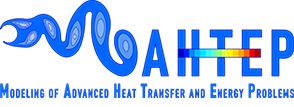Our open-source model instances
TEMOA-Europe
The TEMOA-Europe model is a comprehensive representation of the European energy system, designed to perform long-term energy system optimization analyses within an open-database and open-software environment. The model is publicly accessible at: https://github.com/MAHTEP/TEMOA-Europe.
Model Overview
TEMOA-Europe is built using the TEMOA framework and operates as a capacity expansion energy system optimization model (ESOM). It evaluates the least-cost configuration of energy system technologies and resource allocations to meet predefined energy demands across multiple sectors. The model covers OECD Europe as a single region, using 2005 as the base year and extending its projections to mid-century [1].
Methodology and Assumptions
TEMOA-Europe works under a partial equilibrium framework, where commodity production and consumption are balanced to maximize producer and consumer surplus, reflecting economic welfare. The model assumes perfectly competitive markets with perfect foresight across the entire planning horizon. Energy demands are fixed inputs and must be fully satisfied at each time step.
Regional Representation
The model represents the entire OECD Europe as a single region to simplify data handling and computational requirements while maintaining relevance for EU-level policy analysis. Energy statistics are sourced from the IEA and adjusted based on the EUROfusion TIMES Model. Import and export processes link Europe to the rest of the world, with distinct costs and constraints applied to different trade routes.
Energy Supply Modules
The energy supply side of TEMOA-Europe includes fossil fuel extraction, nuclear fuel cycle processes, renewable energy generation, hydrogen production, carbon capture, utilization and storage (CCUS), and biofuel production [1].
- Fossil Fuel Extraction: Inland extraction of coal, oil, and natural gas with options for trade.
- Nuclear Fuel Cycle: Includes uranium mining, enrichment, and reprocessing of spent fuel.
- Renewable Energy: Covers geothermal, hydro, solar, wind, biomass, and marine sources.
- Hydrogen Production: Multiple pathways, including fossil fuel reforming, biomass gasification, and electrolysis.
- CCUS: Captures CO2 from power and industrial processes for storage or utilization.
- Biofuels Production: Converts various biomass feedstocks into liquid and gaseous fuels.
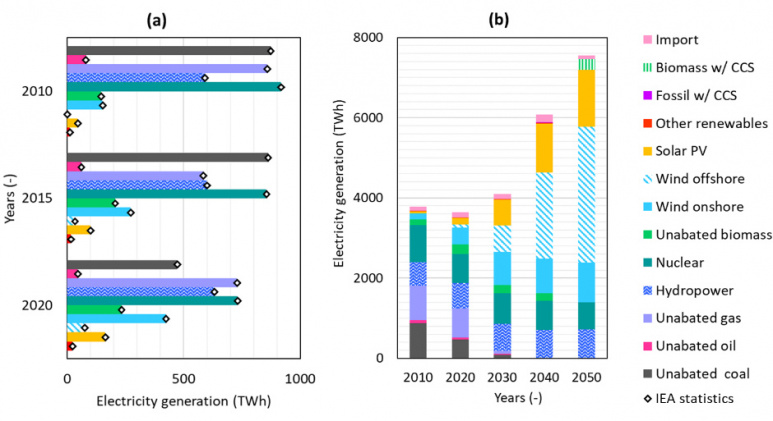
Figure 1. Electricity generation mix from 2010 to 2050 evaluated with TEMOA-Europe. [1]
Energy Demand Modules
Demand sectors include residential, commercial, industrial, transport, and agriculture. Each sector features a variety of technologies to meet final energy service demands, which must be satisfied in every time step.
- Industry: Detailed modeling of energy-intensive subsectors such as steel, cement, and chemicals.
- Transport: Includes road, rail, aviation, and maritime modes with evolving technology options.
- Buildings: Simulates heating, cooling, and appliance usage.
- Agriculture: Considers energy needs for mechanized processes.
CO2 Emissions and Mitigation
TEMOA-Europe tracks greenhouse gas emissions across all sectors and evaluates the potential of various mitigation strategies. Emissions reductions are achieved through energy efficiency improvements, fuel switching, and carbon capture technologies [2], [3].
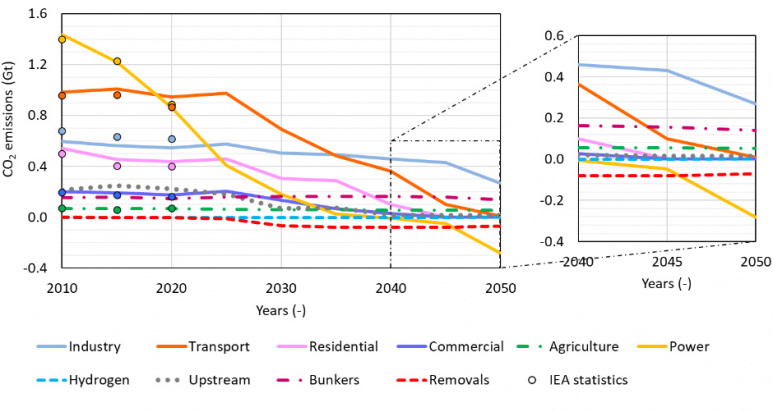
Figure 2. CO2 emissions trajectory by sector evaluated with TEMOA-Europe. [1]
Data Sources and Calibration
The model relies on publicly available data from the IEA, ETM, TIAM-WORLD, and other sources. Technology costs, efficiencies, and operational characteristics are based on literature and existing ESOM databases, with updates for key parameters such as renewable energy costs [1].
Applications and Relevance
TEMOA-Europe supports the evaluation of policies related to the European Green Deal, energy security, and decarbonization pathways. Its open-source nature ensures transparency and reproducibility for researchers, policymakers, and stakeholders.
TEMOA-Italy
The TEMOA-Italy model instance, available at https://github.com/MAHTEP/TEMOA-Italy, is a bottom-up, technology-rich energy system optimization model developed to explore long-term energy scenarios for the Italian energy system. The model adopts a time horizon extending up to 2050, with energy system evolution analyzed in five-year increments. It is built upon historical energy statistics from the International Energy Agency (IEA) for the base year 2006 and calibrated up to 2022 using Eurostat Energy Balances. The model can optimize a reduced set of time periods when solving particularly complex problems to manage computational requirements [4].
Model Structure and Scope
The overall structure of TEMOA-Italy is depicted in Figure 3.
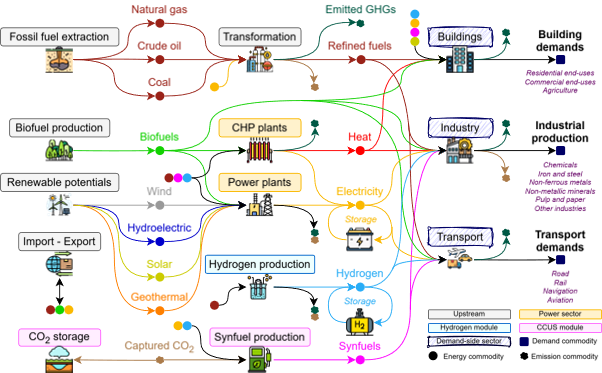
Figure 3. Representation of the TEMOA-Italy energy system.
It shows the linear energy flows across different sectors, from upstream production to final consumption. The model employs a Reference Energy System (RES) framework, describing the interactions among energy carriers, technologies, and end-uses in a transparent and flexible manner.
The energy system is divided into supply-side and demand-side components. The upstream supply sector comprises primary energy production, transformation processes, and international trade. Fossil fuel extraction is limited by proved, probable, and possible reserves, while renewable potentials are constrained by resource availability. Imports and exports are represented through trade processes associated with cost assumptions.
The demand side is split into three primary sectors: buildings, industry, and transport. Each of these sectors includes multiple subsectors to capture the diversity of energy consumption patterns:
- Buildings: End-uses include space heating, space cooling, water heating, lighting, and appliances [5].
- Industry: Energy-intensive subsectors such as chemicals, iron and steel, non-ferrous metals, non-metallic minerals, and pulp and paper are explicitly represented.
- Transport: Passenger and freight transport demands are modeled across multiple modes, including road, rail, aviation, and navigation, as illustrated in Figure 5 [6].
Supply-Side Modeling
The upstream sector, shown schematically in Figure 3, includes fossil and renewable energy production, fuel transformation, and cross-border energy trade. Fossil fuel extraction covers coal, oil, and natural gas, with constraints reflecting available reserves. Biofuel production includes solid biomass, bioethanol, biodiesel, and biogas, with options for biomethane upgrading [2]. Secondary production processes like natural gas liquefaction and gasification are also incorporated. Renewable energy generation potentials, including solar, wind, hydro, biomass, and geothermal, are based on external assessments.
Electricity imports and exports are modeled as virtual processes with cost-driven constraints, while domestic electricity generation is detailed in Figure 4.
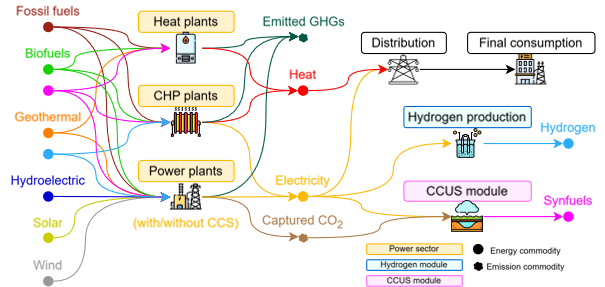
Figure 4. Representation of the TEMOA-Italy power sector.
The power sector includes various generation technologies, combined heat and power (CHP) plants, and heat-only plants. Capacity factors, capacity credits for variable renewable sources, and combined heat-to-power ratios for CHP plants are specified to represent operational characteristics accurately [7].
Demand-Side Dynamics
Energy service demands evolve over time based on sector-specific drivers and elasticities, projected through a demand function incorporating historical trends and future assumptions [8]. For instance, the transport sector (depicted in Figure 5) encompasses road, rail, aviation, and navigation modes, each disaggregated by passenger and freight services. The model aligns with Eurostat classification, distinguishing energy used for transport operations from non-energy uses like lubricants.
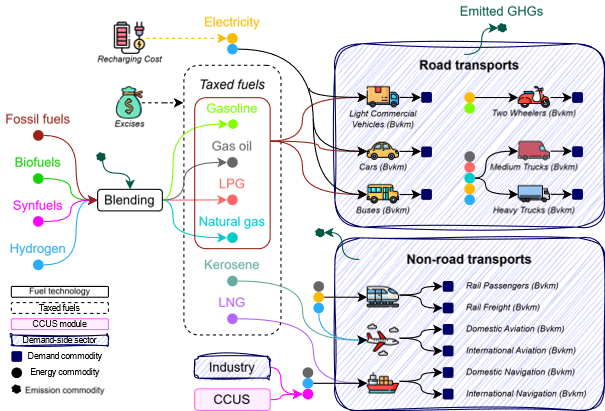
Figure 5. Representation of the TEMOA-Italy transport sector.
Model Applications and Recent Developments
TEMOA-Italy has been employed to analyze various aspects of the Italian energy transition, including industrial sector projections [8], the role of discount rates in investment decisions [6], and energy storage dynamics [7]. The model has also supported studies on the compatibility of energy policies with sustainable development goals [9], investigation of sustainability metrics [10] and the impact of critical raw material availability on energy system security [11], [12].
TEMOA-Piedmont
The TEMOA-Piedmont model is a long-term energy planning tool developed to analyze the energy system of the Piedmont region in Italy. Built from scratch within the open-source TEMOA framework, the model provides insights into the regional energy transition, considering the unique characteristics of Piedmont's energy supply and demand [13], [14]. The model source code and data are openly accessible through the following GitHub repository: https://github.com/MAHTEP/TEMOA-Piedmont.
Model Scope and Structure
Touted as one of the first regional instances of TEMOA, TEMOA-Piedmont focuses on the regional energy landscape through a single spatial region and a time horizon from 2011 to 2050. This time horizon encompasses 15 milestone years, enabling the model to capture long-term dynamics while maintaining a degree of temporal granularity. The base year selection of 2011 was driven by the availability of high-quality census data, facilitating the calibration of the model with historical trends until 2021.
The model structure follows the traditional representation of an energy system, incorporating upstream, transformation, and demand sectors. The upstream sector includes processes for energy extraction, import, and renewable resource potentials. The transformation sector primarily concerns electricity generation, while the demand sectors represent final consumption in buildings, transport, and industry. A schematic of the energy system modeled in TEMOA-Piedmont is illustrated in Figure 6.
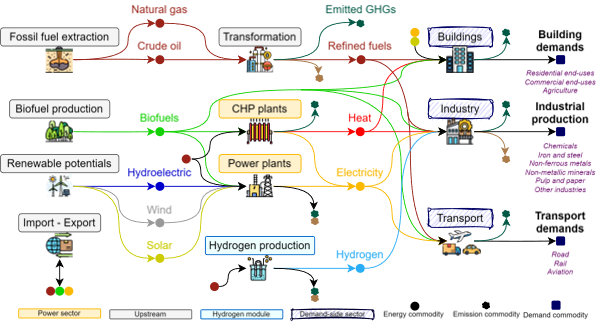
Figure 6. Representation of the TEMOA-Piedmont energy system.
Data Collection and Calibration
Developing an energy system optimization model (ESOM) at the regional level required extensive data collection from multiple sources. The primary data sources include reports from the Italian National Transmission Operator (TERNA) for electricity and the National Mining Office for fossil fuel resources. Additional assumptions were necessary for disaggregating aggregate data into sector-specific components. For instance, gasoline consumption was entirely allocated to the transport sector, while jet kerosene was exclusively assigned to aviation. The model calibration was conducted using a hybrid bottom-up and top-down approach, ensuring alignment with historical energy balances. The comparison between the model-calculated final energy consumption mix for 2012 and the official regional statistics, shown in Figure 7, confirms the validity of the model outcomes [13], [14].
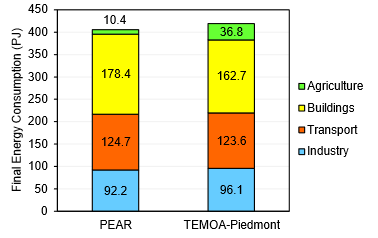
Figure 7. Final energy consumption mix in 2012 evaluated with TEMOA-Piedmont and by regional statistics.
Regional Focus and Sectoral Representation
Tackling energy planning at a regional level allows the model to capture localized characteristics, which may be overlooked in national models. Piedmont, for example, benefits from significant hydroelectric resources due to its mountainous terrain. The model incorporates detailed renewable energy potentials, including solar and wind capacities, while geothermal resources are excluded due to their negligible presence in the region. Air quality regulations limit the deployment of solid biofuels in the residential sector, reflecting local policy measures.
The final energy demand is broken down into multiple subsectors for a comprehensive analysis. The building sector aggregates residential, commercial, and agricultural energy uses. In industry, the model differentiates processes based on energy intensity and fuel types. Transport demand is further disaggregated to distinguish between private, public, and freight transport.
Energy Trade and Policy Implications
Piedmont's energy system traditionally relied on electricity imports until 2017, when regional self-sufficiency was achieved. In TEMOA-Piedmont, this historical shift is modeled through constraints that prohibit electricity imports from 2017 onward. Fossil fuel imports are represented through trade processes linked to national reference prices, as regional prices are assumed to follow national trends. The model also includes projected fuel prices that account for the spikes observed during the 2022 energy crisis.
Policy-Relevant Insights and Applications
Tapping into the regional context, TEMOA-Piedmont supports policy-making by identifying potential barriers and opportunities for the energy transition. Its application to scenario analyses illustrates the impact of local pollution mitigation measures, the exploitation of hydroelectric resources, and the adoption of alternative fuels in the transport sector. The model outcomes align closely with regional energy planning documents, validating its utility as a decision-support tool.
In conclusion, TEMOA-Piedmont offers a versatile platform for exploring the energy transition of the Piedmont region. By leveraging open-access principles, the model fosters transparency and reproducibility in regional energy system modeling, while providing valuable insights to inform both regional and national energy policies.
References
- D. Lerede, V. Di Cosmo, and L. Savoldi, “TEMOA-europe: An open-source and open-data energy system optimization model for the analysis of the European energy mix,” Energy, vol. 308, p. 132850, Nov. 2024, doi: 10.1016/J.ENERGY.2024.132850.
- G. Colucci, D. Lerede, M. Nicoli, and L. Savoldi, “A dynamic accounting method for CO2 emissions to assess the penetration of low-carbon fuels: application to the TEMOA-Italy energy system optimization model,” Appl Energy, vol. 352, no. 121951, Dec. 2023, doi: 10.1016/j.apenergy.2023.121951.
- G. Colucci, D. Lerede, M. Nicoli, and L. Savoldi, “Dynamic Accounting for End-Use CO2 Emissions From Low-Carbon Fuels in Energy System Optimization Models,” Energy Proceedings, vol. 29, 2022, doi: 10.46855/energy-proceedings-10294.
- M. Nicoli, F. Gracceva, D. Lerede, and L. Savoldi, “Can We Rely on Open-Source Energy System Optimization Models? The TEMOA-Italy Case Study,” Energies (Basel), vol. 15, no. 18, p. 6505, Sep. 2022, doi: 10.3390/en15186505.
- M. Nicoli, “A TIMES-like open-source model for the Italian energy system,” Politecnico di Torino, Turin, 2021. Accessed: Jul. 05, 2022. [Online]. Available: https://webthesis.biblio.polito.it/18850/
- M. Nicoli, G. Colucci, V. Di Cosmo, D. Lerede, and L. Savoldi, “Evaluating the impact of hurdle rates on the Italian energy transition through TEMOA,” Appl Energy, vol. 377PC, no. 124633, 2024, doi: 10.1016/j.apenergy.2024.124633.
- M. Nicoli, V. A. D. Faria, A. R. de Queiroz, and L. Savoldi, “Modeling energy storage in long-term capacity expansion energy planning: an analysis of the Italian system,” J Energy Storage, vol. 101PA, no. 113814, 2024, doi: 10.1016/j.est.2024.113814.
- A. Oliva, F. Gracceva, D. Lerede, M. Nicoli, and L. Savoldi, “Projection of Post-Pandemic Italian Industrial Production through Vector AutoRegressive Models,” Energies 2021, Vol. 14, Page 5458, vol. 14, no. 17, p. 5458, Sep. 2021, doi: 10.3390/EN14175458.
- M. Nicoli et al., “Enabling Coherence Between Energy Policies and SDGs Through Open Energy Models: The TEMOA-Italy Example,” in Aligning the Energy Transition with the Sustainable Development Goals: Key Insights from Energy System Modelling, M. Labriet, K. Espegren, G. Giannakidis, and B. O’Gallachoir, Eds., Springer, 2024, pp. 97–118. doi: 10.1007/978-3-031-58897-6_5.
- D. Mosso, G. Colucci, D. Lerede, M. Nicoli, M. S. Piscitelli, and L. Savoldi, “How much do carbon emission reduction strategies comply with a sustainable development of the power sector?,” Energy Reports, vol. 11, pp. 3064–3087, Jun. 2024, doi: 10.1016/J.EGYR.2024.02.056.
- A. Vai, G. Colucci, M. Nicoli, and L. Savoldi, “A Comprehensive Metric to Assess the Security of Future Energy Systems Through Energy System Optimization Models,” Energy Proceedings, vol. 47, 2024, doi: 10.46855/energy-proceedings-11292.
- A. Vai, G. Colucci, M. Nicoli, and L. Savoldi, “May the availability of critical raw materials affect the security of energy systems? An analysis for risk-aware energy planning with TEMOA-Italy,” Mater Today Energy, vol. 48, no. 101805, 2025, doi: 10.1016/j.mtener.2025.101805.
- F. Amir Kavei, M. Nicoli, F. Quatraro, and L. Savoldi, “Enhancing energy transition with open-source regional energy system optimization models: TEMOA-Piedmont,” Energy Convers Manag, vol. 327, p. 119536, Mar. 2025, doi: 10.1016/J.ENCONMAN.2025.119536.
- F. Amir Kavei, M. Nicoli, F. Quatraro, and L. Savoldi, “The Energy Transition in the Age of Open Science: Call for Regional Modelling Solutions,” Energy Proceedings, vol. 47, 2024, doi: 10.46855/energy-proceedings-11294.

